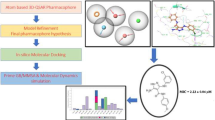Abstract
In the current study, the applicability and scope of 3D-QSAR models (CoMFA and CoMSIA) to complement virtual screening using 3D pharmacophore and molecular docking is examined and applied to identify potential hits against Mycobacterium tuberculosis Enoyl acyl carrier protein reductase (MtENR). Initially CoMFA and CoMSIA models were developed using series of structurally related arylamides as MtENR inhibitors. Docking studies were employed to position the inhibitors into MtENR active site to derive receptor based 3D-QSAR models. Both CoMFA and CoMSIA yielded significant cross validated q2 values of 0.663 and 0.639 and r2 values of 0.989 and 0.963, respectively. The statistically significant models were validated by a test set of eight compounds with predictive r2 value of 0.882 and 0.875 for CoMFA and CoMSIA. The contour maps from 3D-QSAR models in combination with docked binding structures help to better interpret the structure activity relationship. Integrated with CoMFA and CoMSIA predictive models structure based (3D-pharmacophore and molecular docking) virtual screening have been employed to explore potential hits against MtENR. A representative set of 20 compounds with high predicted IC50 values were sorted out in the present study.






Similar content being viewed by others
References
Takayama K, Wang C, Besra GS (2005) Pathway to synthesis and processing of mycolic acids in Mycobacterium tuberculosis. Clin Microbiol Rev 18:81–101
Banerjee A, Dubnau E, Quemard A, Balasubramanian V, Um KS, Wilson T, Collins D, de Lisle G, Jacobs WR (1994) inhA, a gene encoding a target for isoniazid and ethionamide in Mycobacterium tuberculosis. Science 263:227–230
Zhang Y, Heym B, Allen B, Young D, Cole S (1992) The catalase-peroxidase gene and isoniazid resistance of Mycobacterium tuberculosis. Nature 358:591–593
Escalante P, Ramaswamy S, Sanabria H, Soini H, Pan X, Valiente-Castillo O, Musser JM (1998) Genotypic characterization of drug-resistant Mycobacterium tuberculosis isolates from Peru. Tuber Lung Dis 79:111–118
Kuo MR, Morbidoni HR, Alland D, Sneddon SF, Gourlie BB, Staveski MM, Leonard M, Gregory JS, Janjigian AD, Yee C, Musser JM, Kreiswirth B, Iwamoto H, Perozzo R, Jacobs WR, Sacchettini JC, Fidock DA (2003) Targeting tuberculosis and malaria through inhibition of Enoyl reductase: compound activity and structural data. J Biol Chem 278:20851–20859
Sullivan TJ, Truglio JJ, Boyne ME, Novichenok P, Zhang X, Stratton CF, Li H, Kaur T, Amin A, Johnson F, Slayden RA, Kisker C, Tonge PJ (2006) High affinity InhA inhibitors with activity against drug-resistant strains of Mycobacterium tuberculosis. ACS Chem Biol 1:43–53
He X, Alian A, Stroud R, Ortiz de Montellano PR (2006) Pyrrolidine carboxamides as a novel class of inhibitors of enoyl acyl carrier protein reductase from Mycobacterium tuberculosis. J Med Chem 49:6308–6323
He X, Alian A, Ortiz de Montellano PR (2007) Inhibition of the Mycobacterium tuberculosis enoyl acyl carrier protein reductase InhA by arylamides. Bioorg Med Chem 15:6649–6658
Kumar A, Chaturvedi V, Bhatnagar S, Sinha S, Siddiqi MI (2009) Knowledge based identification of potent antitubercular compounds using structure based virtual screening and structure interaction fingerprints. J Chem Inf Model 49:35–42
Rarey M, Kramer B, Lengauer T, Klebe GA (1996) Fast flexible docking method using an incremental construction algorithm. J Mol Biol 261:470–489
Clark MC, Cramer RD III, van Opden Bosch N (1989) Validation of the General Purpose Tripose 5.2 Force Field. J Comput Chem 10:982–1012
Wold S, Ruhe A, Wold H, Dunn WJI (1984) The collinearity problem in linear regression. the partial least squares (PLS) approach to generalized inverses. SIAM J Sci Stat Comput 5:735–743
Wold S, Albano C, Dunn WJ III, Edlund U, Esbensen K, Geladi P, Hellberg S, Johanson E, Lindberg W, Sjostrom M (1984) Multivariate data analysis in chemistry. NATO ASI Ser Ser C 138:17–95
Clark M, Cramer RD III (1993) The Probability of Chance Correlation Using Partial Least Squares (PLS). Quant Struct-Act Relat 12:137–145
Bush BL, Nachbar RB (1993) Sample-distance partial least squares: PLS optimized for many variables, with application to CoMFA. J Comput-Aided Mol Des 7:587–619
Gohlke H, Hendlich M, Klebe G (2000) Knowledge-based scoring function to predict protein-ligand interactions. J Mol Biol 295:337–356
SYBYL Molecular Modeling System, Version 7.1 (2005) Tripos Inc, St Louis, MO
Hurst T (1994) Flexible 3D searching - the directed tweak technique. J Chem Inf Comput Sci 34:190–196
Salum LB, Polikarpov I, Andricopulo AD (2007) Structural and Chemical Basis for Enhanced Affinity and Potency for a Large Series of Estrogen Receptor Ligands: 2D and 3D QSAR Studies. J Mol Graphics Modell 26:434–442
Honorio KM, Garratt RC, Polikarpov I, Andricopulo AD (2007) 3D QSAR Comparative Molecular Field Analysis on Nonsteroidal Farnesoid X Receptor Activators. J Mol Graphics Modell 25:921–927
Bringmann G, Rummey C (2003) 3D QSAR Investigations on antimalarial naphthylisoquinoline alkaloids by comparative molecular similarity indices analysis (CoMSIA), based on different alignment approaches. J Chem Inf Comput Sci 43:304–316
Bohm M, Sturzebecher J, Klebe G (1999) 3D QSAR analyses using CoMFA and CoMSIA to elucidate selectivity differences of inhibitors binding to trypsin, thrombin, and factor Xa. J Med Chem 42:458–477
Acknowledgments
This manuscript is CDRI communication number 7706. This work was supported by the grants from Council of Scientific and Industrial Research (CSIR-India) funded network project NWP0034 (Validation of identified screening models and development of new alternative models for evaluation of new drug entities). Ashutosh Kumar thanks CSIR for fellowship.
Author information
Authors and Affiliations
Corresponding author
Rights and permissions
About this article
Cite this article
Kumar, A., Siddiqi, M.I. Receptor based 3D-QSAR to identify putative binders of Mycobacterium tuberculosis Enoyl acyl carrier protein reductase. J Mol Model 16, 877–893 (2010). https://doi.org/10.1007/s00894-009-0584-0
Received:
Accepted:
Published:
Issue Date:
DOI: https://doi.org/10.1007/s00894-009-0584-0




